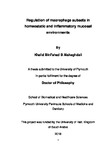Regulation of macrophage subsets in homeostatic and inflammatory mucosal environments
| dc.contributor.supervisor | Foey, Andrew | |
| dc.contributor.author | Alshaghdali, Khalid | |
| dc.contributor.other | Faculty of Health | en_US |
| dc.date.accessioned | 2018-08-03T11:46:59Z | |
| dc.date.issued | 2018 | |
| dc.identifier | 10418407 | en_US |
| dc.identifier.uri | http://hdl.handle.net/10026.1/11981 | |
| dc.description.abstract |
The interaction between epithelial cells and macrophages is integral to mucosal immune fate: determining the decision between tolerance and immune activation/inflammation. Endotoxin tolerisation (ET) is a circumstance where cells go through a hypo-responsive state, unable to respond to further endotoxin-LPS challenge. Mucosal macrophages (MΦs) have a dual functionality that determines tolerance to commensal organisms or immune response to entropathogens such as E. coli. In the case of mucosal inflammatory pathologies, such as Crohn’s disease, this state of tolerance is broken, resulting in destruction of gut mucosal tissue where the macrophage phenotype has been altered from a regulatory M2-like subset phenotype to an inflammatory M1-like subset phenotype, responding to both pathogenic and commensal bacteria. Chronic inflammation by bacterial pathogen related molecular patterns (PAMPs), such as LPS, is well established to induce tolerisation. The aims of this project were firstly, to characterise the control of macrophage differentiation in a mucosal setting by investigating the immunomodulatory effects of PAMPs, such as LPS in presence or absence of TNFα and to investigate ET mechanisms associated with MΦ subsets responding to the entropathogen E. coli K12-LPS. Secondly, to investigate the effect of epithelial cells on macrophage subsets behaviour upon inflammation and ET. M1- and M2-like MΦs were generated in vitro from the THP-1 monocyte cell line by differentiation with PMA and vitamin D3, respectively, whereas differentiated epithelial cells (Caco-2) were obtained by long term culturing for 21 days. A transwell co-culture system of Caco2 cells and MΦ subsets was developed to mimic the cell-to-cell cross-talk between epithelial cells and immune cells. Mono- and co-culture models were pre-treated with either LPS, TNFα or IL-1β prior to stimulation by PAMPs. TNFα, IL-1β, IL-18, IL-6 and IL-10 were qualified by ELISA. Cytokines, PRRs and endogenous negative regulatory molecules were detected by RT-PCR and WB and epithelial barrier function was measured by trans epithelial electrical resistance (TEER). ET induced by K12-LPS failed to demonstrate a differential subset-specific response in MΦ mono-culture system whereas, LPS differentially suppress LPS induced cytokine expression in MΦ co-culture system. Tolerised M1- and M2-like MΦs exhibited a significant reduction in expression and secretion of pro-inflammatory cytokines and comparable levels of anti-inflammatory cytokine, IL-10. The suppression of pro-inflammatory cytokine in these MΦs appeared to be linked to the differential TLR4 expression and up-regulation of negative regulators, such as IRAK-M and Tollip. In addition, MΦ subsets differentially responded to inflammation induced by pro-inflammatory cytokines, TNFα and IL-1β in mono- and co-culture models. In conclusion, tolerisation induced in MΦs is presented by the suppression of pro-inflammatory cytokine, which is associated with corresponding up-regulation of IL-10, TLR4 receptor and the negative regulators, in a subset-independent manner. In the case of cross-talk between epithelial cells and macrophages however, a differential sensitivities to ET was displayed. These findings allow more understanding of MΦ subsets functions and ET mechanisms, which may be beneficial for the development of in-vitro models of MΦ subsets and therapeutics targeting Crohn’s diseases. | en_US |
| dc.description.sponsorship | University of Hail, Kingdom of Saudi Arabia | en_US |
| dc.language.iso | en | |
| dc.publisher | University of Plymouth | |
| dc.subject | Endotoxin Tolerisation | |
| dc.subject | TNFα, IL-10, IRAK-M, THP-1 | |
| dc.subject | Macrophage subsets | en_US |
| dc.subject.classification | PhD | en_US |
| dc.title | Regulation of macrophage subsets in homeostatic and inflammatory mucosal environments | en_US |
| dc.type | Thesis | |
| plymouth.version | publishable | en_US |
| dc.identifier.doi | http://dx.doi.org/10.24382/498 | |
| dc.rights.embargodate | 2019-08-03T00:00:00Z | |
| dc.rights.embargoperiod | 12 months | en_US |
| dc.type.qualification | Doctorate | en_US |
| rioxxterms.version | NA |
Files in this item
This item appears in the following Collection(s)
-
01 Research Theses Main Collection
Research Theses Main


